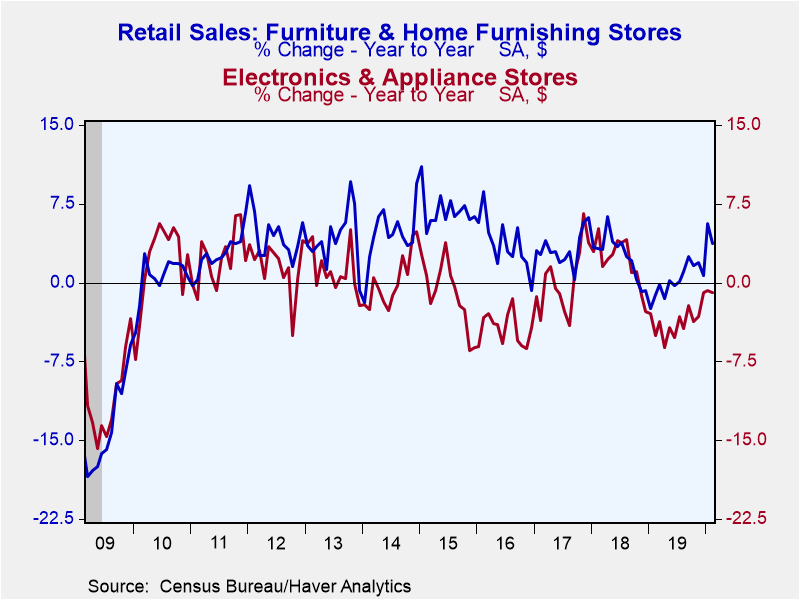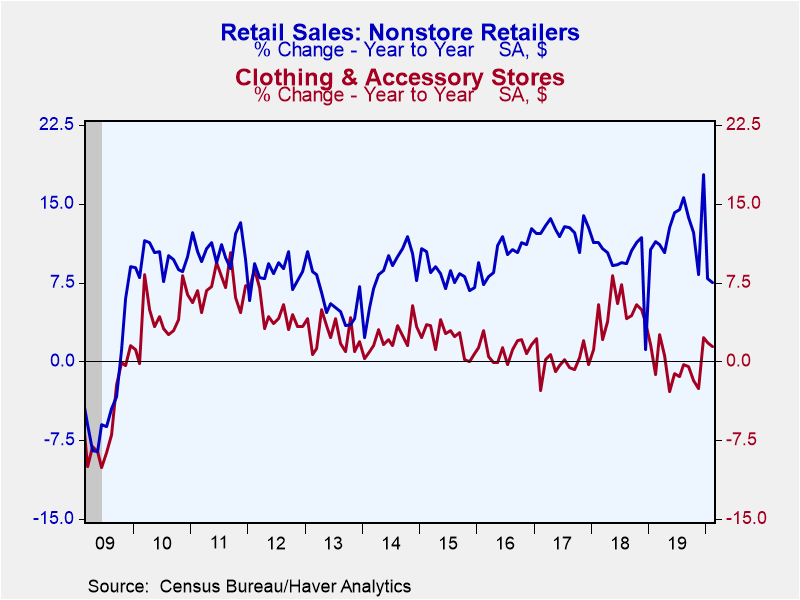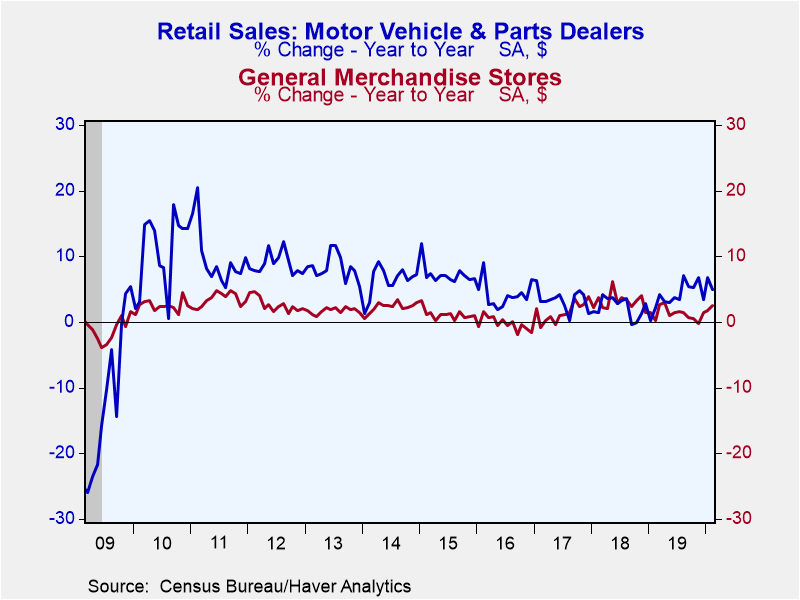 Global| Mar 17 2020
Global| Mar 17 2020U.S. Retail Sales Weaken Broadly Ahead of Major Coronavirus Impacts
by:Tom Moeller
|in:Economy in Brief
Summary
Total retail sales including food service establishments declined 0.5% (+4.3% y/y) during February after rising 0.6% in January, revised from 0.3%. A 0.2% gain had been expected in the Action Economics Forecast Survey. Retail sales [...]
Total retail sales including food service establishments declined 0.5% (+4.3% y/y) during February after rising 0.6% in January, revised from 0.3%. A 0.2% gain had been expected in the Action Economics Forecast Survey. Retail sales excluding motor vehicles & parts fell 0.4% (+4.2% y/y) following a 0.6% increase, revised from 0.3%. A 0.1% uptick had been anticipated.
Retail sales alone fell 0.5% (+4.2% y/y) during February following a 0.6% January rise, revised from 0.1%. A 1.4% decline (-1.0% y/y) in electronics & appliance store sales held back overall purchases. They had risen 0.6% in each of the prior two months. Sales of building materials also weakened 1.3% (+5.1% y/y) last month. Apparel store sales fell 1.2% (+1.4% y/y), down hard for the second straight month. Motor vehicle purchases weakened 0.9% (+4.9% y/y) as unit sales of light vehicles (reported earlier this month) eased 0.2%. Rounding out last month's sales weakness was a 0.4% easing (+3.8% y/y) in furniture & home furnishings store sales and a 0.1% slip (+2.5% y/y) in general merchandise store sales. Sales at department stores alone weakened 0.2% (-5.8% y/y) and have been falling steadily during all of the economic expansion. Offsetting some of these declines was a 0.7% increase (7.5% y/y) in nonstore retail sales after a 0.2% rise. These gains followed four consecutive months of decline. Also improving were sporting goods, hobby, book & music store sales by 0.1% (1.9% y/y) which came after two months of strong increase.
Gasoline & service station sales weakened 2.8% (+2.7% y/y) as gasoline prices slumped.
In the nondiscretionary sales categories, food & grocery store sales held steady (4.0% y/y) after easing 0.2% in January. Sales of health & personal care product stores slipped 0.1% (0.6% y/y) following two months of 0.8% increase.
Restaurant purchases fell 0.5% (5.2% y/y) following two months of modest increase.
The retail sales data can be found in Haver's USECON database. The Action Economics forecast is in the AS1REPNA database.
| Retail Spending (% chg) | Feb | Jan | Dec | Feb Y/Y | 2019 | 2018 | 2017 |
|---|---|---|---|---|---|---|---|
| Total Retail Sales & Food Services | -0.5 | 0.6 | 0.0 | 4.3 | 3.5 | 4.8 | 4.6 |
| Excluding Autos | -0.4 | 0.6 | 0.5 | 4.2 | 3.4 | 5.5 | 5.0 |
| Retail Sales | -0.5 | 0.6 | -0.1 | 4.2 | 3.4 | 4.6 | 4.5 |
| Retail Less Autos | -0.4 | 0.5 | 0.4 | 4.0 | 3.2 | 5.3 | 4.8 |
| Motor Vehicle & Parts | -0.9 | 0.8 | -1.8 | 4.9 | 4.0 | 2.3 | 3.4 |
| Gasoline Service Stations | -2.8 | -0.4 | 0.9 | 2.7 | 0.3 | 12.6 | 8.9 |
| Food Service & Drinking Places Sales | -0.5 | 0.8 | 0.9 | 5.2 | 4.4 | 6.3 | 5.9 |
Tom Moeller
AuthorMore in Author Profile »Prior to joining Haver Analytics in 2000, Mr. Moeller worked as the Economist at Chancellor Capital Management from 1985 to 1999. There, he developed comprehensive economic forecasts and interpreted economic data for equity and fixed income portfolio managers. Also at Chancellor, Mr. Moeller worked as an equity analyst and was responsible for researching and rating companies in the economically sensitive automobile and housing industries for investment in Chancellor’s equity portfolio. Prior to joining Chancellor, Mr. Moeller was an Economist at Citibank from 1979 to 1984. He also analyzed pricing behavior in the metals industry for the Council on Wage and Price Stability in Washington, D.C. In 1999, Mr. Moeller received the award for most accurate forecast from the Forecasters' Club of New York. From 1990 to 1992 he was President of the New York Association for Business Economists. Mr. Moeller earned an M.B.A. in Finance from Fordham University, where he graduated in 1987. He holds a Bachelor of Arts in Economics from George Washington University.










